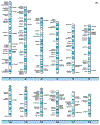Single Gene and Syndromic Causes of Obesity: Illustrative Examples
- PMID: 27288824
- PMCID: PMC7377403
- DOI: 10.1016/bs.pmbts.2015.12.003
Single Gene and Syndromic Causes of Obesity: Illustrative Examples
Abstract
Obesity is a significant health problem in westernized societies, particularly in the United States where it has reached epidemic proportions in both adults and children. The prevalence of childhood obesity has doubled in the past 30 years. The causation is complex with multiple sources, including an obesity promoting environment with plentiful highly dense food sources and overall decreased physical activity noted for much of the general population, but genetic factors clearly play a role. Advances in genetic technology using candidate gene approaches, genome-wide association studies, structural and expression microarrays, and next generation sequencing have led to the discovery of hundreds of genes recognized as contributing to obesity. Polygenic and monogenic causes of obesity are now recognized including dozens of examples of syndromic obesity with Prader-Willi syndrome, as a classical example and recognized as the most common known cause of life-threatening obesity. Genetic factors playing a role in the causation of obesity will be discussed along with the growing evidence of single genes and the continuum between monogenic and polygenic obesity. The clinical and genetic aspects of four classical but rare obesity-related syndromes (ie, Prader-Willi, Alström, fragile X, and Albright hereditary osteodystrophy) will be described and illustrated in this review of single gene and syndromic causes of obesity.
Keywords: Albright hereditary osteodystrophy; Alström syndrome; Prader–Willi syndrome; candidate obesity genes; fragile X syndrome; genomic imprinting; syndromic obesity.
Copyright © 2016 Elsevier Inc. All rights reserved.
Figures






References
-
- Friedman JM. Modern science versus the stigma of obesity. Nat Med. 2004;10(6): 563–569. - PubMed
-
- Lyon HN, Hirschhorn JH. Genetics of common forms of obesity: a brief overview. AmJClin Nutr. 2005;82(1):215S–217S. - PubMed
-
- Behan DF, Cox SH, Lin Y, et al. Obesity and its Relation to Mortality and Morbidity Costs. Schaumburg, Illinois: Society of Actuaries: Committee on Life Insurance Research; 2010: 1–78
Publication types
MeSH terms
Grants and funding
LinkOut - more resources
Full Text Sources
Other Literature Sources
Medical
Miscellaneous

